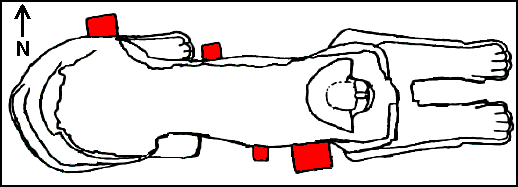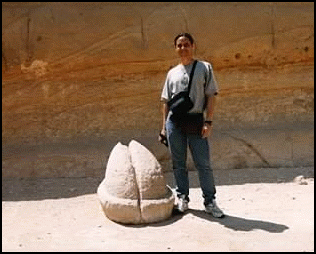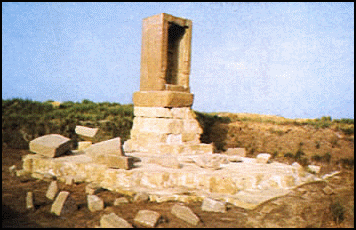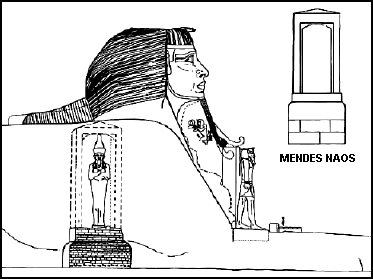
Plan after Lehner, 1991
One aspect of the Great Sphinx at Giza that has somehow been overlooked by "fringe" authors is the presence of four odd masonry boxes that are situated against the body of the Sphinx at floor level, two on the north side and two on the south.
Masonry "boxes" (in red).

Plan after Lehner, 1991
August Mariette uncovered the boxes while clearing the sand around the Sphinx in the 1850s. At that time, there were five boxes, but one on the north side has since disappeared. The arrangement of the boxes is asymmetrical and seems to make little sense. What was their purpose?
Mariette first thought they served as buttresses to support the slope of the masonry on the body of the Sphinx. But he changed his mind when he found pieces of a colossal statue of Osiris that was, he wrote, composed of separate blocks. A travel writer in 1856 counted the blocks: there were 28 (Laorty-Hadji, L'Egypte, p. 382). The fragments included a badly worn face and a white crown made of limestone.
Limestone crown, 1997.

© Photo copyright Larry Orcutt
Based on this evidence, Mariette concluded that the boxes had served as bases or pedestals for large cult statues. Examination of the masonry indicates that the boxes were constructed in the 18th Dynasty at the latest (during Phase 1 reconstruction), but probably earlier.
Dimensions of the Boxes (in feet).
| Description | Width (E-W) | Length (N-S) | Height |
|---|---|---|---|
| N Large Box | 13.1 | 11.2 | 8.9 |
| N Small Box | 8.0 | 7.5 | 5.7 |
| S Large Box | 17.3 | 13.1 | 10.8 |
| S Small Box | 6.2 | 7.9 | 4.7* |
*Top course of stones missing.
Mark Lehner made a theoretical reconstruction of the Osiride statue in his 1991 Yale University doctorate dissertation, Archaeology of an image: The Great Sphinx of Giza. According to Lehner,
The double crown, when complete would have been about 1.6 m. [5.2 feet] tall and about 1 m. [3.3'] long (front to back). This would be proportionate on a statue about 7.5 m. [24.6'] tall. A statue of this size must have been part of the site where it was found. Since it is not likely that this was the statue at the chest of the Sphinx, we must examine the possibility that it was the statue to which Mariette made reference. [p. 369]
Mendes naos.

© Photo copyright Baines and Málik, Atlas of Ancient Egypt, 1988, p. 166
For the design of the reconstructed statue, Lehner used a small statuette found by Hassan near the north side of the Sphinx. The figure depicts the mummiform king wearing the double crown and holding an ankh sign. As New Kingdom cult statues were provided with a shrine, or naos, Lehner speculated that such was the case with the Osiride statue and so used the naos of Mendes (see above), carved from a single block of granite and of similar size, as a model for his reconstruction. "A colossal naos," wrote Lehner, "could have been considered the pr of the Osiride statue." [p. 374] In ancient times, a stairway likely led up to the naos.
Sphinx reconstruction.

© Copyright Lehner, Archaeology of an image: The Great Sphinx of Giza, 1991, fig. 9.16
Despite the evidence that the masonry boxes served as pedestals for statues, Lehner is not entirely convinced:
The boxes attached to the Sphinx statue are odd structures that defy immediate and easy explanation. Even odder is the fact that they have received little comment except that of Mariette (1882, 95)... Like the S large box, both the S and N small boxes show evidence of use as plinths or bases - flat socles built upon a fill of limestone and mortar. However there remains some doubt. The notion of the Sphinx flanked with smaller statues on pedestals here and there against the leonine body seems, at first, bizarre. The N large box is covered and has never been dismantled. It does not seem well constructed or properly located as a pedestal for a statue. [p. 267]
Catchpenny Mysteries © copyright 2000 by Larry Orcutt.